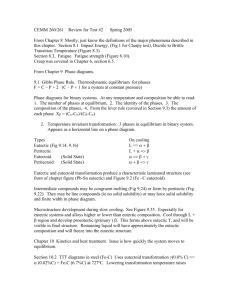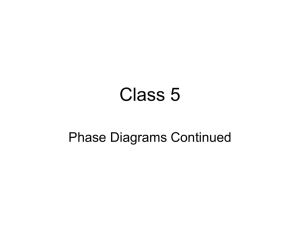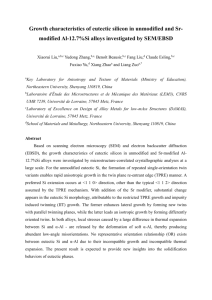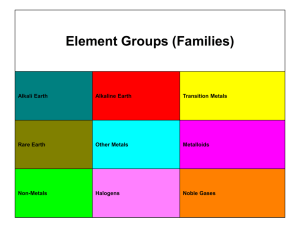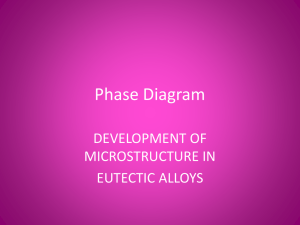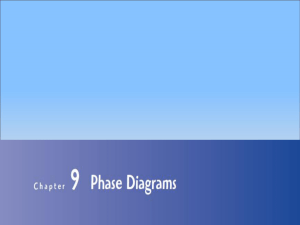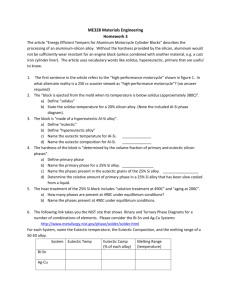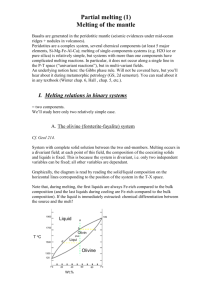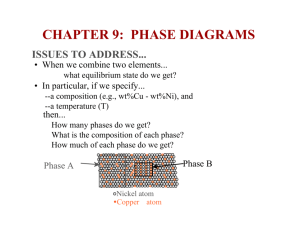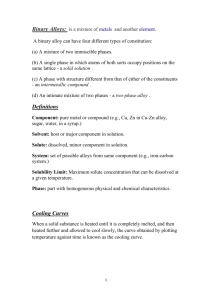L-5: Thermodynamics of Mixtures (Chapter 7)
advertisement
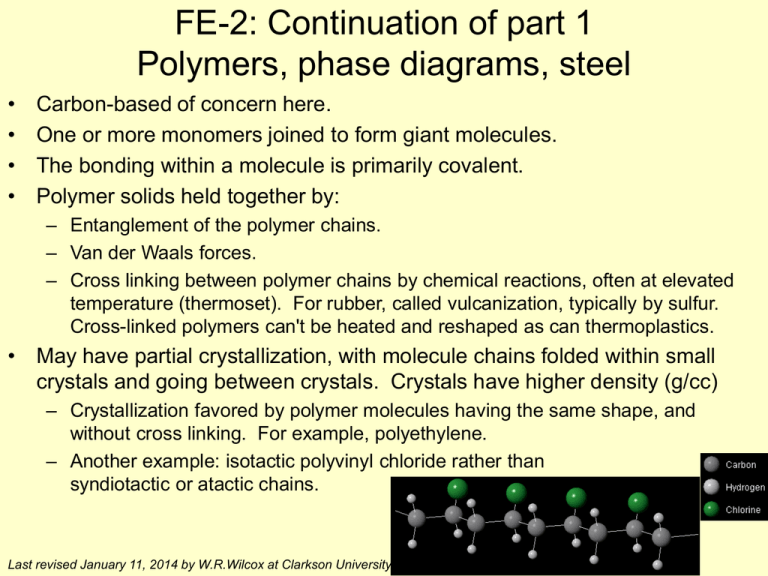
FE-2: Continuation of part 1 Polymers, phase diagrams, steel • • • • Carbon-based of concern here. One or more monomers joined to form giant molecules. The bonding within a molecule is primarily covalent. Polymer solids held together by: – Entanglement of the polymer chains. – Van der Waals forces. – Cross linking between polymer chains by chemical reactions, often at elevated temperature (thermoset). For rubber, called vulcanization, typically by sulfur. Cross-linked polymers can't be heated and reshaped as can thermoplastics. • May have partial crystallization, with molecule chains folded within small crystals and going between crystals. Crystals have higher density (g/cc) – Crystallization favored by polymer molecules having the same shape, and without cross linking. For example, polyethylene. – Another example: isotactic polyvinyl chloride rather than syndiotactic or atactic chains. Last revised January 11, 2014 by W.R.Wilcox at Clarkson University. Mechanical behavior of polymers • Plastic deformation of polymers usually involves the movement of polymer molecules past one another. • In addition to brittle and plastic brittle behavior, can also be highly elastic (elastomeric). • An amorphous polymer may behave like a brittle glass below a glass transition temperature and a rubbery ductile solid at intermediate temperatures. • For small deformations, elastomeric the behavior depends on how quickly the stress is applied and released. If this is fast, the material behaves elastically. If very slow, it flows and takes a new permanent shape. (Think silly putty.) • For intermediate rates, the deformation is viscoelastic, so that only part of the strain is recovered when the stress is removed. From the FE exam handbook • Tg is the glass-transition T, below which it's brittle. • Tm is the melting T, above which it flows when stressed and can be formed into shapes. (But it's not a usual liquid.) • Notice that these are not sharp transitions like the melting point of nonpolymers. Conditions favoring solubility in solid metals Interstitial impurities • Atomic radius of impurity must be much smaller than host, e.g. C (0.071nm) in Fe (0.1241nm). Substitutional impurities: Hume-Rothery rules 1) Atomic size: The closer the atomic radii the greater the solubility. 2) Electronegativity: The closer the electronegativities, the greater the solubility. True when metals are near one another in the periodic table. If not near, formation of an intermetallic compound is favored. • For complete solid solubility, the pure components must have the same crystal structure, i.e. "isomorphous." Uncommon. • The electronegativities must be near and the atomic radii close. • Most often get limited solubility with formation of other phase(s). The solubility usually depends strongly on temperature. • Example of complete electroneg Crystal r (nm) solid solubility: Ni-Cu Structure Ni FCC 1.9 0.1246 Cu FCC 1.8 0.1278 Nickel-copper binary phase diagram at 1 atm • Only melt above the liquidus. • Only solid below the solidus. • Both in between • Isotherm shows composition of the liquid and solid in equil. • Called a tie line At B: T = __oC? Solid = __%Ni? Liquid = __%Cu? 1 Liquid T 1. 2. 3. 4. 5. 2 Melting point pure B Solubility of B Melting point pure A Solubility of A Eutectic point 3 Solution 2 and solid B 4 A+4 When two phases are in equilibrium with one another they are at the same temperature. 5 Find compositions in equilibrium with one another by drawing an isotherm, called a “tie line.” For example: Solid A and solid B in equilibrium with one another A Fraction of B B Binary phase diagram with no solid solubility – simple eutectic Eutectic with some solubility, e.g. Pb-Sn Greek letters and used for solid solutions. Metallurgists call eutectic liquid going to solid the “eutectic reaction” L + Compound formation, e.g. Mg-Pb Two eutectics Intermetallic compound Mg2Pb shown at exact comp’n, but would exist over small comp’n range. Some compounds decompose before melting Peritectic • At the peritectic point, when heated a solid goes to another solid and a melt. Vice versa when cooled. • Metallurgists call this the “peritectic reaction” and write it: S1 + L heat S2 • At 184oC, 27wt%Bi goes from to + L. • Where’s the eutectic point? • What phases can be in equilibrium at the peritectic point? • At A? A Pb cool Bi Eutectoid points • A eutectoid point is where a solid dissociates to two solids when cooled. Analogous to a eutectic point, at which a liquid dissociates to two solids when cooled. For example, V-Zr phase diagram: • Eutectoid point: A • Zr V2Zr + Zr • What is sequence of phases as A is cooled ? •L • L + Zr • Zr • Zr + Zr • V2Zr + Zr Liquid immiscibility and monotectic points • Sometimes melts separate into two liquids below a certain temperature, e.g. Pb & Zn: • At the monotectic point, a liquid separates into a solid and the other liquid. • Here liquid A Zn + liquid B • What happens as we cool from the blue dot? • What do we have at the red oval? Zn Pb Another viewpoint For example: simple eutectic with no solid solubility. Fraction of A equals the distance from the mixture composition to the opposite phase (B) divided by the total distance between phases A & B Cmix Distance to opposite phase Check: the closer the mixture composition is to a phase the more of that phase must be present, in the limit 100%! Total distance Fraction of grains with eutectic structure Liquid T B+L A+L opposite total A Weight fraction of B • Consider the red point. • Rather than asking how much of A and B are present, we can ask what weight fraction of the grains is eutectic and what fraction is primary B. • To do this, treat the eutectic as a compound. • Then use the lever rule in the usual way to calculate the weight fraction of grains that have the eutectic B microstructure. • The fraction of eutectic is opposite/total. Fe – Fe3C (cementite): C steels and cast iron Eutectoid reaction to form pearlite • When slowly cool eutectic or eutectoid compositions get a lamellar structure. • For example, 0.76 wt% C austenite gives pearlite, which consists of alternating layers of ferrite and cementite. To left of eutectoid, get pearlite + ferrite steel. To right, brittle pearlite+Fe3C.
